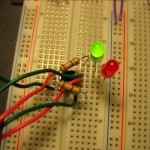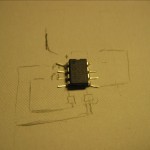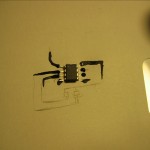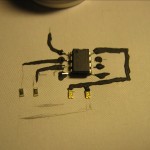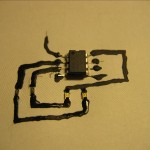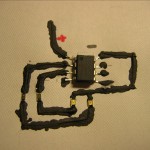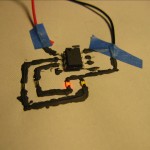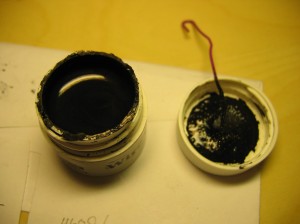 So I got some conductive glue a while back, and I have been meaning to see if you can create circuits out of paper and glue instead of PCB and copper. They would be much easier to prototype, though not as durable. The paper and glue circuits might be flexible though, which is a neat think to dream about.
So I got some conductive glue a while back, and I have been meaning to see if you can create circuits out of paper and glue instead of PCB and copper. They would be much easier to prototype, though not as durable. The paper and glue circuits might be flexible though, which is a neat think to dream about.
The other day I finally got around to actually trying paper and glue circuits out. I used a discarded envelope and spread the glue with a paperclip. My first circuit (two LEDs, 180 ohms in series on each, at 3.3V) worked pretty well. The LEDs weren’t as bright as I hoped, and there was a considerable difference in brightness between the two, meaning the glue has a pretty high resistance. It was so high that it was making a voltage divider and driving the LEDs unequally. I made a test swatch and measured 460 ohm per inch for the a single layer of the glue. That means that you can’t make traces much longer than 2 or 3 inches before the resistance starts to become a problem for many applications.
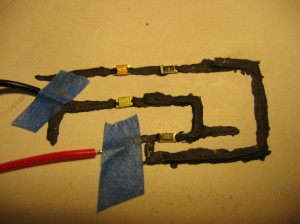 Other than the high resistance, the glue performed excellently. It dries fast (package says 24hrs, but its more like 30 – 45 min), and is pretty strong and flexible. Also its not tacky when its dried. Or rubbery. And the ease of using SMD parts with the glue can’t be beat. Though I have yet to try anything with a fine pitch. But the resistance makes a large scale circuit out of the question. So to try and cut the resistance, I embedded thin uncoated wire in the glue. The wire was just a single strand from some stranded 20AWG 300V insulated wire that I stripped. With the addition of the wire, the resistance dropped to between 20 and 50 ohm per inch. Which is pretty workable for a large scale circuit. I’m thinkin and 8.5×11 sheet of paper. You could even use carefully measured distances as your resistors, though I am not sure how much power this stuff can handle.
Other than the high resistance, the glue performed excellently. It dries fast (package says 24hrs, but its more like 30 – 45 min), and is pretty strong and flexible. Also its not tacky when its dried. Or rubbery. And the ease of using SMD parts with the glue can’t be beat. Though I have yet to try anything with a fine pitch. But the resistance makes a large scale circuit out of the question. So to try and cut the resistance, I embedded thin uncoated wire in the glue. The wire was just a single strand from some stranded 20AWG 300V insulated wire that I stripped. With the addition of the wire, the resistance dropped to between 20 and 50 ohm per inch. Which is pretty workable for a large scale circuit. I’m thinkin and 8.5×11 sheet of paper. You could even use carefully measured distances as your resistors, though I am not sure how much power this stuff can handle.
Included are some photos of the circuit, both on and off. Also the test swatch for the trace resistances and a switch I made but have yet to hook up. Though I have verified it is conductive. Things I want to investigate more are how well the glue handles voltage (the package says “low voltage”… is that 30V or 300V?), power dissipation (can we dump a watt or two into it? seems possible for a long trace), and data communication (what is its bandwidth?)
-
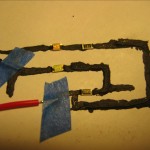
-
My first paper and glue circuit.
-
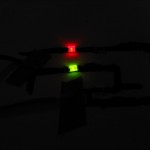
-
First paper/glue circuit powered with lights off.
-
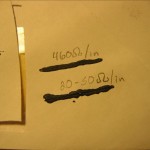
-
paper/glue resistance test swatch
-
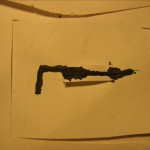
-
My first attempt at a switch made out of paper and glue.
-
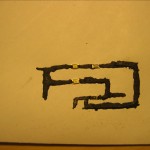
-
First paper/glue circuit – Unpowered
-
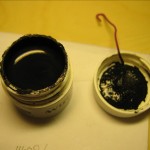
-
Conductive Glue
-
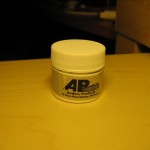
-
Conductive Glue (exterior)
